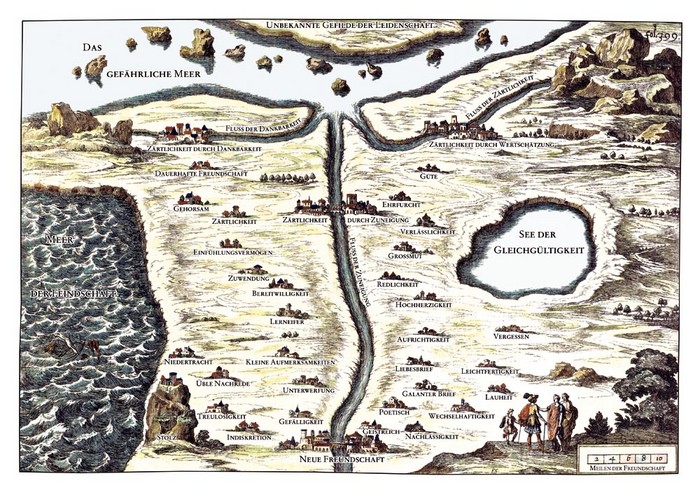Konversationskunst (Conservational Art) Kurd Alsleben, Antje Eske, and friends
16 Oct 2010 - 09 Jan 2011

François Chauveau, « Carte du pays de Tendre », publiziert in: Madeleine de
Scudéry, « Clélie. Histoire romaine », Teil 1, Paris: Augustin Courbé, 1654
Scudéry, « Clélie. Histoire romaine », Teil 1, Paris: Augustin Courbé, 1654
The global networking of computers has led to an exchange of all kinds of messages, which has exceeded all expectations in terms of quantity. Social Software services, such as Facebook and Twitter, and virtual worlds like Second Life generate new forms of interpersonal behavior.
Kurd Alsleben, Antje Eske, and friends explore the artistic possibilities that appear on the scene with these new forms of communication and develop a conversational art that can refer back to a long tradition: from the classical “ars sermonis,” the courts of muses of the Italian renaissance, the French salon culture of the seventeenth and eighteenth centuries, through to Surrealism and Dadaism.
Conversation initiators: Kurd Alsleben, Zorah Mari Bauer, Stefan Beck, Steffi Beckhaus, Julia Bonn, Sascha Büttner, Wolfgang Coy, Tanja Döring, Jochen Engel, Antje Eske, Detlev Fischer, Mike Hentz, Heiko Idensen, Thorsten Juckel, Stefanie Körner, Tilo Kremer, Michael Kress, Sabine Kullenberg, Matthias Lehnhardt, Volker Lettkemann, Michaela Melián, Cord Passow, Julian Rohrhuber, Heidi Salaverría, Claudia Schmölders, Roland Schröder-Kroll,
Axel Sylvester, Bernhard H.F. Taureck, Rolf Todesco, Martin Warnke, Matthias Weiß, Renate Wieser, Chrisdian Wittenburg, and Frank Wörler.
“Konversationskunst” is an art of exchange that sets itself apart from everyday communication, whereby this exchange is not limited to talking. An exchange of media—from spoken word to image, from text to music or sign language, pen and paper to the Internet—opens up new spaces of association and expands the horizon of what is possible to say. “Konversationskunst” does not produce a work, but instead, allows a shared, playful gathering of experiences and an emergence of ideas transcending current social common sense. The guiding motto of this conversing is: “Alone, I don’t know how to continue.”
An exhibition and conversations with visitors taking place vis-à-vis in the exhibition space and on the Internet offer an amusing form of exchange that cultivates an essential sense: the sense of sociality.
Curated by Margit Rosen
Kurd Alsleben, Antje Eske, and friends explore the artistic possibilities that appear on the scene with these new forms of communication and develop a conversational art that can refer back to a long tradition: from the classical “ars sermonis,” the courts of muses of the Italian renaissance, the French salon culture of the seventeenth and eighteenth centuries, through to Surrealism and Dadaism.
Conversation initiators: Kurd Alsleben, Zorah Mari Bauer, Stefan Beck, Steffi Beckhaus, Julia Bonn, Sascha Büttner, Wolfgang Coy, Tanja Döring, Jochen Engel, Antje Eske, Detlev Fischer, Mike Hentz, Heiko Idensen, Thorsten Juckel, Stefanie Körner, Tilo Kremer, Michael Kress, Sabine Kullenberg, Matthias Lehnhardt, Volker Lettkemann, Michaela Melián, Cord Passow, Julian Rohrhuber, Heidi Salaverría, Claudia Schmölders, Roland Schröder-Kroll,
Axel Sylvester, Bernhard H.F. Taureck, Rolf Todesco, Martin Warnke, Matthias Weiß, Renate Wieser, Chrisdian Wittenburg, and Frank Wörler.
“Konversationskunst” is an art of exchange that sets itself apart from everyday communication, whereby this exchange is not limited to talking. An exchange of media—from spoken word to image, from text to music or sign language, pen and paper to the Internet—opens up new spaces of association and expands the horizon of what is possible to say. “Konversationskunst” does not produce a work, but instead, allows a shared, playful gathering of experiences and an emergence of ideas transcending current social common sense. The guiding motto of this conversing is: “Alone, I don’t know how to continue.”
An exhibition and conversations with visitors taking place vis-à-vis in the exhibition space and on the Internet offer an amusing form of exchange that cultivates an essential sense: the sense of sociality.
Curated by Margit Rosen
